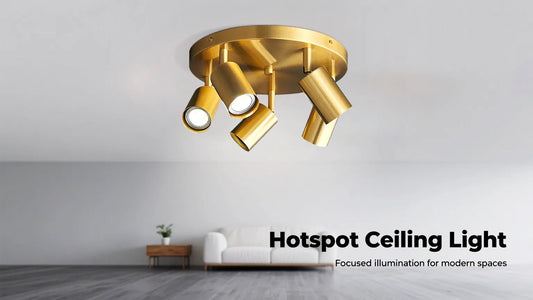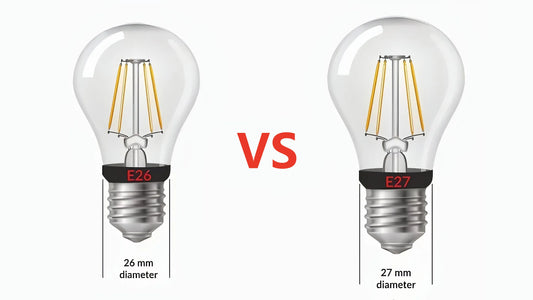A Comprehensive Guide to Common Light Bulb Base Types: Classifications, Features, and Applications
When purchasing light bulbs or fixtures, beyond the previously discussed E26 and E27 Edison screw bases, there are numerous other base types available on the market. Each type is designed to fit specific bulb models and is used in residential, commercial, and industrial settings. Without understanding the differences between these bases, you may easily encounter issues such as "bulbs not fitting" or "functional mismatches." Below is a detailed breakdown of common light bulb base types, categorized into four groups: "Edison Screw," "Bayonet Cap," "Plug-in," and "Special-Purpose." Charts are included to clarify key distinctions.
I. Edison Screw (ES) Bases: The Most Common for Residential Use, Differentiated by Diameter
Edison screw bases are the most prevalent in household lighting due to their easy installation and stable contact. Their core designation follows the format "E + number," where "E" stands for "Edison Screw" and the number represents the base diameter in millimeters. In addition to the familiar E26 and E27, the following types are also widely used:
Table 1: Comparison of Common Edison Screw Base Types
|
Base Type |
Screw Diameter |
Compatible Voltage |
Compatible Bulb Types |
Typical Applications |
Features |
|
E14 |
14mm |
220-240V (Mainstream) |
Low-wattage LED bulbs, CFLs, candle bulbs |
Crystal chandeliers (small arm bulbs), wall sconces, small table lamps, refrigerator lighting |
Compact size, also known as "small screw base," ideal for fixtures with limited space |
|
E27 |
27mm |
220-240V (Global Residential Standard) |
Universal LED bulbs, CFLs, incandescent bulbs, halogen bulbs |
Living room ceiling lights, bedroom table lamps, standard downlights, floor lamps, kitchen pendants |
Highest versatility; compatible with over 90% of regular residential fixtures |
|
E26 |
26mm |
110-120V (North American Standard) |
North American-standard LED bulbs, incandescent bulbs |
Imported American-style fixtures (vintage industrial pendants), North American appliance lighting (ovens, refrigerators) |
Visually similar to E27 but differs by 1mm in diameter; incompatible with E27 voltages |
|
E12 |
12mm |
110-120V (North America) |
Low-wattage decorative bulbs, Christmas light strings |
Small wall sconces in North American homes, holiday decorations, under-cabinet lighting |
Also called "candelabra base," smaller than E14; rarely used in China |
|
E40 |
40mm |
220-240V (Primarily Commercial) |
High-wattage LED bulbs, high-pressure sodium lamps, metal halide lamps |
Factory lighting, streetlights, large shopping mall pendants, stadium lighting |
Thick screw design, supports high wattages (usually over 50W); rarely used in homes |
Key Visual Identification Tips:
• Larger diameters mean thicker screws: E40 > E27/E26 > E14 > E12. You can quickly distinguish them by the base size with the naked eye.
• E14 and E27 are the most common in residential settings: "Small bulb beads" in crystal chandeliers are typically E14, while living room ceiling lights and large table lamps usually use E27.
II. Bayonet Cap (BC) Bases: Anti-Loose, Common in Older Fixtures
Bayonet cap bases secure bulbs by "clipping the bulb pins into the base slots." No twisting is required for installation, making them easy to use and resistant to vibration. Their core designation follows the format "B + number," where "B" stands for "Bayonet Cap" and the number refers to the base diameter or pin spacing. Common types include:
Table 2: Comparison of Common Bayonet Cap Base Types
|
Base Type |
Base Diameter/Pin Spacing |
Compatible Voltage |
Compatible Bulb Types |
Typical Applications |
Features |
|
B22 |
22mm diameter, 180° pin spacing |
220-240V (Mainstream for Older Fixtures) |
Incandescent bulbs, CFLs, older LED bulbs |
Ceiling lights in older homes, balcony lights, hallway lights, emergency lights |
The most common bayonet type, also known as "Bayonet 22." Installation involves "aligning with slots, pressing, and twisting" to secure |
|
B15 |
15mm diameter, 180° pin spacing |
220-240V |
Low-wattage decorative bulbs, indicator lights |
Small wall sconces, children’s room cartoon fixtures, appliance indicators (e.g., microwaves) |
Compact size, smaller than B22, suitable for miniaturized fixtures |
|
B22d |
22mm diameter, double contacts (d = double contact) |
220-240V |
High-wattage bayonet bulbs, special-purpose bulbs |
Commercial emergency lights, some stage lights |
Dual-contact design for stronger current-carrying capacity and more stable contact |
Differences from Edison Screw Bases:
• Installation Method: Edison screw bases require "twisting to tighten," while bayonet bases need "pressing + twisting to lock."
• Stability: Bayonet bases offer better vibration resistance, making them suitable for kitchens (vibration from range hoods) and balconies (wind-induced vibration).
• Current Status: Most new residential fixtures now use Edison screw bases (E27), while bayonet bases (B22) are mainly found in older fixtures or specific scenarios.
III. Plug-in Bases: Efficient Installation, Common in Commercial and Specialized Fixtures
Plug-in bases connect bulbs via "direct pin insertion" or "clip-on fixation," enabling quick installation. They are ideal for scenarios requiring frequent bulb replacement and are commonly used in commercial or recessed fixtures such as downlights, spotlights, and track lights. Their designations often include "GU," "G," or "MR."
Table 3: Comparison of Common Plug-in Base Types
|
Base Type |
Pin Type/Spacing |
Compatible Bulb Types |
Typical Applications |
Features |
|
GU10 |
Dual pins (G = Pin, U = U-shaped clip), 10mm pin spacing |
MR16 spotlights (LED/halogen), downlights |
Ceiling downlights, accent wall spotlights, under-cabinet lighting, commercial display case lighting |
No transformer required (compatible with 220V direct power supply). Installation involves "inserting and twisting 90° to secure." The mainstream choice for residential recessed lighting |
|
GX53 |
Dual pins, 53mm pin spacing, no clip (direct plug-in) |
Ultra-thin LED panel lights, flat-panel lights |
Ultra-thin kitchen downlights, bathroom integrated ceiling lights, commercial ceiling panel lights |
Extremely thin (only a few millimeters thick), ideal for "seamless recessed" installations. Insert directly into the base without twisting |
|
MR16 (Integrated Base) |
Mostly GU5.3 bases (5.3mm pin spacing) |
MR16 halogen bulbs, low-voltage LED spotlights |
Accent wall spotlights, counter spotlights, outdoor landscape lights |
Requires a 12V transformer (low-voltage power supply). Smaller than GU10 with stronger light focusing, suitable for precise lighting needs |
|
G9 |
Dual thin needle-like pins, 9mm spacing |
G9 LED bulbs, halogen bulbs |
Crystal chandelier (small bulb beads), bathroom vanity lights, small wall sconces |
Slender pins and compact size, ideal for decorative fixtures. Insert directly into the base without twisting |
Critical Reminders:
• GU10 and MR16 (GU5.3) are easily confused: GU10 is compatible with 220V high voltage and requires no transformer, while MR16 needs 12V low voltage and must be used with a transformer. Mismatching will cause the bulb to fail or burn out.
• Plug-in bases are mostly "single-type compatible": Damaged bulbs must be replaced with the same type; compatibility with other base types is not possible.
IV. Special-Purpose Bases: Designed for Professional Equipment or Scenarios
These bases are engineered for specific needs such as water resistance, high-temperature resistance, or high voltage. They are commonly used in outdoor, industrial, or medical settings but may occasionally be encountered in homes:
Table 4: Comparison of Common Special-Purpose Base Types
|
Base Type |
Key Features |
Compatible Bulb Types |
Typical Applications |
Notes |
|
E27 Waterproof (IP65/IP67) |
Equipped with a rubber gasket for water and dust resistance |
Waterproof LED bulbs, garden lights |
Outdoor garden lights, balcony pendants, bathroom shower area fixtures |
Must be paired with waterproof bulbs. Ensure the gasket is properly sealed during installation to prevent moisture intrusion |
|
G13 (T8/T5 Tube Base) |
Dual pins, 13mm spacing, elongated shape |
T8/T5 fluorescent tubes, LED tubes |
Office linear lights, kitchen ceiling lights, garage lighting |
Bases are fixed at both ends of the tube. Insert the tube parallel to the base during installation. Always turn off power before replacement to avoid electric shock |
|
E17 |
17mm screw diameter, between E14 and E27 |
Medium-wattage LED bulbs, oven lights, refrigerator lights |
Oven interior lighting, large refrigerator lighting, commercial display case lighting |
High-temperature resistant (some models withstand over 200°C); rarely used in regular residential fixtures |
|
AR111 (Integrated Base) |
Mostly GU10 or GX53 interfaces with a reflective cup |
AR111 LED spotlights, halogen bulbs |
Mall window lighting, museum exhibit lighting, outdoor floodlights |
Long light range and strong focusing, suitable for long-distance lighting. Ensure proper fixture heat dissipation |
V. Quick Identification and Selection: 3 Steps to Determine the Right Base Type
You don’t need to memorize all base types by heart. Follow these 3 steps to quickly identify the right one:
1. Check the Label on the Old Bulb/Fixture (Most Direct Method)
• Bulbs: Reputable bulbs clearly mark the base type (e.g., "E14," "GU10," "B22") on the base.
• Fixtures: The fixture manual or inner side of the base will indicate compatible base types (e.g., "Fits E27/GU10 bulbs").
2. Preliminary Judgment Based on Scenario (Supplementary Reference)
|
Scenario |
Likely Compatible Base Type |
|
Residential living room ceiling lights, large table lamps |
E27 |
|
Crystal chandelier (small bulb beads), small wall sconces |
E14/G9 |
|
Balcony lights in older homes, emergency lights |
B22 |
|
Ceiling downlights, accent wall spotlights |
GU10 |
|
Outdoor garden lights, bathroom shower area lights |
Waterproof E27 |
|
Imported American-style fixtures |
E26 |
3. Measure Key Dimensions (When No Label Is Available)
• Edison Screw: Measure the base diameter (E14 → 14mm, E27 → 27mm).
• Bayonet Cap: Measure the base diameter (B22 → 22mm, B15 → 15mm).
• Plug-in: Measure the pin spacing (GU10 → 10mm, GU5.3 → 5.3mm).
VI. Common Misconceptions About Base Types
1. "GU10 and MR16 are interchangeable": False! GU10 uses 220V high voltage, while MR16 requires 12V low voltage. Mismatching will burn out the MR16 bulb or cause the GU10 bulb to fail.
2. "A B22 bayonet base can fit an E27 Edison screw bulb": False! Bayonet and screw bases have completely different structures and physical dimensions; they are incompatible.
3. "Waterproof bases don’t need waterproof bulbs": False! A waterproof base only prevents external moisture from entering the base. If the bulb itself is not waterproof, its internal components will still be damaged by moisture. Always pair "waterproof bases with waterproof bulbs."
Conclusion: Choose the Right Base Type Based on Scenario
Different base types are designed to fit bulbs of varying wattages, sizes, and functions, as well as different usage environments. For residential use, focus on remembering the four core types: E14 (small screw), E27 (large screw), B22 (bayonet), and GU10 (downlight/spotlight). For commercial or special scenarios (e.g., outdoor, recessed lighting), further consider "voltage requirements (high/low voltage), protection rating (water/dust resistance), and installation method (plug-in/screw)" to narrow down your choice.



